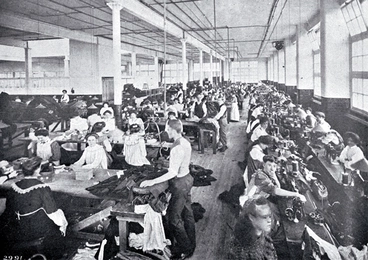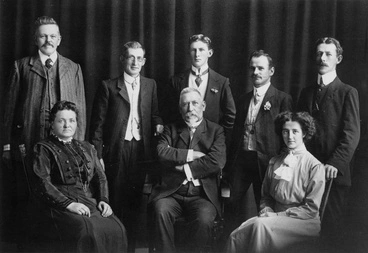NZ's first women's trade union
A DigitalNZ Story by Zokoroa
Dunedin Tailoresses' Union from 12 July 1889 to June 1945
Unions, Trade Unions, Employment, Dunedin, Working conditions, Workers, Industries, Tailoresses, Clothing
The first women’s trade union in NZ formed in 1889 in Dunedin over the poor working conditions for tailoresses in the clothing industry. As well as working in factories, women also took work home and were paid by the number of items sewn ("piecework") rather than by the number of hours spent. The plight of the women workers became known as the "sweating system" which led to a committee being formed to campaign for the fairer treatment of workers and the regular inspection of their workplaces. When employers refused to negotiate, the committee formed the Dunedin Tailoresses' Union on 12 July 1889 which operated until 1945.
On 12 July 1889, NZ's 1st women’s trade union - Dunedin Tailoresses' Union - was formed due to poor working conditions
Women worked long hours in factories & at home for low wages (Image: Women workers at Roslyn Woollen Mills, Otago, 1907)
Alexander Turnbull Library
Women working at the New Zealand Clothing Factory in Dunedin which began in 1873
Clothing company workroom
Manatū Taonga, the Ministry for Culture and Heritage
The interior of a clothing factory with women operating irons at the middle table, 1909
The interior of a clothing factory
Christchurch City Libraries
Clothing factory with women workers at machines, c.1910
Zachariah, Joseph, 1867-1965: Clothing factory
Alexander Turnbull Library
>>>>>>>>>>>>>>>>>>>>>>
Backstory:
The Employment of Females Act of 1873 made it illegal to employ women in factories for more than 8 hours in any one day
However, this was not enforced in factories
The University of Auckland Library
The Employment of Females and Others Act 1881 placed further restriction on hours of work & provided for overtime rates
Although inspectors were appointed, the Act was not fully enforced to ensure overtime was paid at penal rates
National Library of New Zealand
The plight of tailoresses, including single woman apprentices, became known as the "sweating system"
As well as working in factories, women took work home & were paid by the number of items ("piecework") rather than hours
Alexander Turnbull Library
Between 1881-1890, the economic depression was accompanied by a steady worsening in conditions of employment
Image: Women engaged in the sweating system appearing in Court for stealing few articles of clothing (1891)
National Library of New Zealand
Many young single women were employed as apprentices to learn the clothing trade & received low wages
Image: Annie Heron, aged about 15, wearing the dress she made to graduate as a tailoress, 1885
Auckland Libraries
During 1888 & 1889, the "sweating system" was highlighted in sermons & public lectures by Rev Rutherford Waddell
Waddell was a Presbyterian minister & former draper's apprentice who'd immigrated with his wife from Ireland in 1877
Hocken Collections - Uare Taoka o Hākena, University of Otago
In Nov 1888, the Presbyterian Synod in Dunedin agreed ministers & officer-bearers would discourage "sweating system"
Rev Waddell's address included that children were also being discouraged from going to school to sew clothing at home
National Library of New Zealand
On 21 Feb 1889, a public meeting in Dunedin agreed to Rev Waddell's motion to form a committee to discuss next steps
The Committee began campaigning for the fairer treatment of workers and the regular inspection of their workplaces
National Library of New Zealand
When employers in Dunedin refused to negotiate, the Committee formed the Dunedin Tailoresses' Union on 12 July 1889
1st president was Rev Waddell & secretary was John A. Millar of Seamen's Union. Male workers could join but few did.
National Library of New Zealand
In July 1889, media reported the situation of tailoresses in Auckland was under review by Trades and Labour Council
Cases reported included women on probation being underpaid & required to work long hours & would take work home
National Library of New Zealand
In Aug 1889, Tailoresses' Union threatened strike action when the Manufacturers' Association refused to increase wages
Consequently, local employers reduced hours & raised wages by c.2 percent, & in some cases as high as 40 per cent
National Library of New Zealand
In Oct 1889, media reported some firms had reacted negatively to the Union, & discharged members from the workplace
(Article in the Star (8 Oct 1889) comments on a male union member who was discharged)
National Library of New Zealand
On 26 Nov 1889, a meeting held in Wellington by tailoresses, machinists, & pressers decided to form a union like Dunedin
A representative from the Dunedin Union was also sent to Auckland to assist in the formation of an union
National Library of New Zealand
In 1890, public pressure led to the Govt setting up a Royal Commission to enquire into higher wages & working conditions
The Sweating Commission investigated the conditions in clothing & other factories, & those women doing piecework at home
Manatū Taonga, the Ministry for Culture and Heritage
Although the Commission found cases of exploitation, it didn't agree these were general enough to call "sweating system"
Findings showed the new rates were still not high enough for women to support themselves & many had to rely on parents
National Library of New Zealand
In Dec 1890, the Dunedin Tailoresses' Union held its first annual picnic at Purakanui which c.1000 attended
National Library of New Zealand
The Factories Act 1891 was passed following the Commission's findings & included inspection & reinforcement provisions
National Library of New Zealand
During the first 3 months, inspectors required improvements & alterations to 913 factories
Manatū Taonga, the Ministry for Culture and Heritage
In 1891, the Federated Tailoresses’ Union was formed & held its first conference in July in Christchurch
Attendees were from Dunedin, Christchurch, Wellington & Auckland unions. From 1891, membership was restricted to women.
Manatū Taonga, the Ministry for Culture and Heritage
1891: Harriet Morison (front left) became Union's 1st woman secretary until 1896 & 13 other women were on the Executive
Morison also campaigned for women's suffrage & the 1891 petition had 4000 Dunedin signatures including 2/3 working women
Manatū Taonga, the Ministry for Culture and Heritage
In Dec 1892, the Tailoresses' Union & other unions threatened strike action against sweated labour
(Political cartoon: "The Comet - another threatened strike", 3 Dec 1892)
Auckland Libraries
In May 1895, the Dunedin Tailoresses' Union held a Scottish fair to raise funds
It intended to form a convalescent home & a benefit society
National Library of New Zealand
In Aug 1896, a fair was held in Auckland by the Tailoresses' Union
Auckland Libraries
Aug 1896: Performers at the fair held in Auckland by the Tailoresses' Union
Auckland Libraries
In 1898, a national award for factory tailoresses was achieved under arbitration
National Library of New Zealand
In 1900, the Union's ten year campaign for female factory inspectors was successful & the staffing was extended in 1909
The Dept of Labour's inspectors included two former Union secretaries - Harriet Morison & Selina Hale
National Library of New Zealand
1900: The laundry department at A Clark and Sons shirt factory, Grey Lynn, Auckland
Auckland Libraries
On 6 Sept 1905, the Arbitration Court settled a dispute between the Dunedin Tailoresses' Union & clothing manufacturers
The Award to take effect from 1 Sept 1905 set out the rates of pay and working conditions
National Library of New Zealand
In 1905, Tailors and Tailoresses at D Luen & Co was established in Palmerston North that year
Palmerston North City Library
In 1910, an uniform national award was negotiated after Auckland joined the Federated Tailoresses' Union in 1909
National Library of New Zealand
c.1916: Women working in Hallenstein's clothing factory in Dunedin
Hocken Collections - Uare Taoka o Hākena, University of Otago
1920: Sewing machine operators at a clothing factory in Christchurch
Alexander Turnbull Library
In 1921, New Zealand Federated Clothing Trade Employees Union succeeded the 1891 Federation Tailoresses' Union
In 1928, the headquarters was moved from Dunedin to Christchurch & unions in other areas began amalgamating with it
National Library of New Zealand
1928-30: Storefront of the New Zealand Hallenstein Brothers Clothing Factory shop
Display of shirts, ties, blouses and material
Puke Ariki
1928-30: Storefront of the New Zealand Hallenstein Brothers Clothing Factory shop
Display shows top hats & pattern clusters
Puke Ariki
1939: Women operating sewing machines at Haydon Clothing Manufacturing Co Ltd, Palmerston North
Palmerston North City Library
In 1939, Dunedin Tailoresses' Union held its Golden Jubilee banquet
Over the years, the union membership had ranged between 350 and 1400
Auckland Libraries
In 1945, Dunedin Tailoresses' Union voted to amalgamate with new Otago & Southland Clothing and Related Trades Union
Postal ballot showed 66% of 1068 votes returned wanted to join the 174 male tailors, cutters & pressers
Te Hikoi Museum
In June 1945, Dunedin Tailoresses' Union closed & new union joined N.Z. Federated Clothing Trade Employees Union
Dunedin's achievements included higher wages, reduced hours, Dpt of Lab. female factory inspectors & legislative changes
National Library of New Zealand
Find out more:
First women's trade union formed, URL: https://nzhistory.govt.nz/page/first-womens-trade-union-formed, (Manatū Taonga — Ministry for Culture and Heritage), updated 6-Jul-2020
Ian Breward. 'Waddell, Rutherford', Dictionary of New Zealand Biography, first published in 1993, updated February, 2019. Te Ara - the Encyclopedia of New Zealand, https://teara.govt.nz/en/biographies/2w1/waddell-rutherford
-
Melanie Nolan & Penelope Harper: NZ History: "Dunedin Tailoresses' Union, 1889 – 1945", URL: https://nzhistory.govt.nz/women-together/dunedin-tailoresses-union
This DigitalNZ story was compiled in July 2024
















